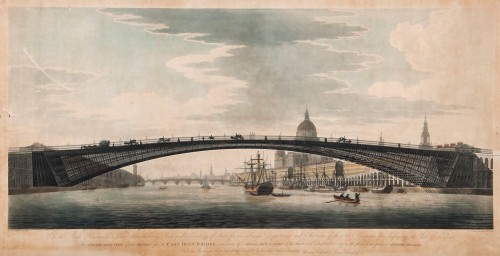Just over 200 years ago, plans were shown off to replace the venerable London Bridge with a massive single-span iron bridge.
As it happens, old London Bridge was in dire need of something to replace it, and the City of London put out a call for suggestions. Most people expected a generic bridge to be built, from stone of course, and the only issue was what would it look like.
Then along came Thomas Telford, who was increasingly obsessed with building bridges from iron. Not without justification, as he was doing quite well at it already, having built a number of smaller road bridges from iron.
However, a commission to replace London Bridge was too tempting, and he proposed something staggering. Staggering then, and probably not much less if it were shown off today.
This was a single span bridge with an arch no less than 600 feet wide, and a full 65 feet of clearance above the Thames. By comparison, the current London Bridge has a clearance of just 29 feet.
The height of the bridge comes from the confusion about how to deal with cargo ships that were currently blocked from getting further upstream than the old London Bridge.
In 1800, the government was considering either an option to construct a number of docks in what was, unsurprisingly, later to be known as docklands or replace London Bridge with something that could permit ships of up to 200 tons to pass under it.
There would then be docks and wharfs built between the new London Bridge and Blackfriars.
Telford says in letters that he twice presented his proposals to the government’s Select Committee on the Port of London, proposals which he said would “render the port of London as perfect as possible”.
His plan was eventually published in late 1801, and by April 1802, he was claiming to have support from several members of the Royal Family.
The bridge itself was fairly well thought out, with seven wide ribs leaping across the river and cross-braced for support. The design allowed for any single segment to be removed and replaced when necessary without closing the bridge to traffic.
Above the bridge, the roadway would have been 45 feet wide in the centre, although the splayed out widthwise to 90 feet on either side of the river.
Despite regal support, and some admiring comments, the general reaction was of incredulity that such a structure could even be suggested, let alone built.
A committee took to studying the plans, and after some time concluded that while safe from an engineering perspective, it was just too bold an experiment and dismissed the plan.
The problems of shallow bridge spans was to emerge again 30 years later, when a much smaller bridge of brick, but with a similar profile was built by Isambard Kingdom Brunel, and he faced similar levels of distrust about the ability for such a shallow span to support itself.
But back to the iron bridge, the main reason it wasn’t built was the difficulty of building such wide approaches on either side of the river, and the high costs of demolishing so many buildings.
A rather boring London Bridge was built, from iron and stone, but the great iron bridge which would have rivalled Tower Bridge for fame remained just a drawing on paper and a collection of letters.
And the London Bridge that was built? Turned out not to be such a good idea, and was replaced in the 1970s. It ended up in the USA, as a tourist attraction.
Sources:
The Life of Thomas Telford, Samuel Smiles, page 178-182
The Encyclopedia Britannica: or, Dictionary of arts, sciences, 1857, vol 12
An Encyclopædia of Civil Engineering, Historical, Theoretical, and Practical. Published 1847.








There’s a story that when Brunel proposed another shallow brick bridge to carry the GWR mainline across the Thames between Taplow and Maidenhead, he was faced with the same skepticism. The fearful GWR brass ordered Brunel to leave the wooden scaffolding in place.
In one version of the story Brunel did so, but lowered it so that it wasn’t actually supporting anything; the scaffolding was later washed away in a flood, revealing the subterfuge. In another version, at the opening ceremony for the bridge Brunel dramatically dropped away the supporting framework, revealing that the bridge was sound exactly as he had claimed.
The first version of the story is better supported historically, but I really hope the second is true!
That’s the same brick arch bridge I am talking about in the article.
I suspected it might be. As an even more random aside, the bridge is currently (?) being upgraded with overhead electrification as part of CrossRail. Doing so in an architecturally sensitive way has not been easy it seems.
Also, Brunel is probably my favorite Victorian engineer.